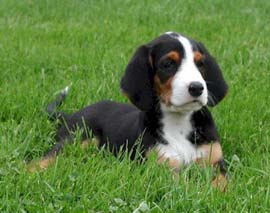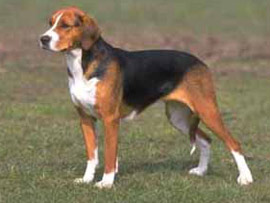FCI Standard: 51 / 17/07/1997
FCI Klasifikacija:
Grupa: 6 - Goniči i srodne pasmine
Sekcija: 1 - Goniči
Podsekcija: 1.2 - Psi srednje veličine
Sa radnim ispitom.
Zemlja porijekla: Finska
Podrijetlo: Ova je pasmina poznata već u osamnaestom stoljeću, ali se znatnije rasprostranila istom krajem devetnaestog stoljeća.
Opis: Gonič srednjeg uzrasta, snažan ali i okretan mršave i plemenite glave, dobro istaknute njuške, širokih i pokretnih nosnica Njegovu ljepotu potcrtavaju i uši visoko nasađene koje odstoje od obraza i djeluju kao krila.
Standard traži snažno zubalo, ravan i mršav vrat dubok prsni koš. Uvučen trbuh, snažne i mršave noge, elastične meke uši, dug rep. Dlaka je gusta i tvrda na dodir.
Boja dlake: crn plašt, s jarkim paležem na glavi, trbuhu, bedrima, nogama, bjeline se nalaze na gubici, vratu, grudima, donjem dijelu nogu i na vrhu repa, dakle trobojan gonič vrlo sličan srpskom trobojcu.
Narav: Pristupačan, vrlo energičan u lovu.
Držanje: U ljetnim mjesecima koristi se za lov na zeca uz ostalu nisku i visoku divljač. Ovaj je gonič vrlo cijenjen u svojoj domovini, ali je slabo poznat drugdje.
 |
 |

Finski gonič -Finnish Hound - Suomenajokoira
FCI-Standard N°51 / 14. 11. 2000 / GB
FINNISH HOUND
(Suomenajokoira)
ORIGIN : Finland.
DATE OF PUBLICATION OF THE ORIGINAL VALID STANDARD : 17.07.1997.
UTILIZATION : A hound for hunting hare and fox by following the scent. Eager to hunt also in difficult circumstances. He works independently, he is a versatile tracker and pursues the quarry with resonant barking.
CLASSIFICATION F.C.I. : Group 6 Scenthounds and related breeds.
Section 1.2. Medium sized hounds.
With working trial.
BRIEF HISTORICAL SUMMARY : In Finland in the beginning of 19th century there were in addition to the finnish country dogs also many dogs resembling the European hound breeds. After the establishment of the Finnish Kennel Club in 1889 the development of the Finnish Hound began. The first standard was written in 1932. The breeding associations in different parts of the country were very important to the development of the breed. The crosses made in the beginning of the 20Th century have also helped to create the stock from which the Finnish Hound descends.
GENERAL APPEARANCE : Tricoloured, medium in size, evenly high ; clearly longer in body than the height at the withers, strongly built but not heavy. The supporting area of standing is as long as the body or slightly longer, in front it is as broad as the chest and in rear at least as broad as in the front. The sex should be clearly stamped.
IMPORTANT PROPORTIONS :
· The ratio between the length of the body and the height at the withers is of 1,1 to 1.
· The depth of the chest is a half of the height at the withers.
· The length of the muzzle is equal to the length of the skull. The length of the skull is equal to its width and depth.
BEHAVIOUR / TEMPERAMENT : Calm, energetic and friendly, never aggressive.
HEAD
CRANIAL REGION : Seen from the front of even breadth, domed at the top of the skull. Forehead slightly convex in profile. The topline of the skull is parallel to the bridge of the nose ; the furrow between the eyes is barely visible ; eyebrows and occiput are clearly visible.
Stop : Slight but clearly defined, accentuated by the eyebrows.
FACIAL REGION :
Nose : Well developed, black ; large and mobile nostrils.
Muzzle : Equal in length to the skull, moderately deep, slightly tapering ; the bridge of the nose is straight. The lower lip forms the lower line which is almost parallel with the topline of the muzzle.
Lips : Well developed, good pigmentation. The upper lip beautifully curved. The lips and the corners of the mouth are close fitting.
Jaws/Teeth : The jaws are strong. Teeth well developed, symmetrically set in the jaws. Complete normal dentition. Tight and complete scissor bite.
Cheeks : Moderately clean.
Eyes : Medium in size, not protruding, slightly oval, of a dark brown colour, looking forward. Expression calm. The eyelids are black.
Ears : Hanging with the front edge close to the head. Turned so that the back edge points outwards, the tip nearly forwards. Set on the line drawn from the nose to the eyes. Flat, reaching over half of the muzzle when drawn forward.
NECK : Of medium length, muscular, rather clean, the topline only slightly arched. When standing the tip of the nose is at the level of the topline or slightly higher.
BODY :
Back : Of medium length, straight and muscular.
Loin : Rather short and powerful.
Croup : Well developed, long and strong, slightly oblique. In profile the topline continues to a beautifully arched croup.
Chest : Long and deep, reaching to the elbows. Ribs well sprung ; the forechest clearly visible.
Underline : Slightly rising.
TAIL : Low set, slightly arched, reaching the hocks. Strong at the base, tapering towards the end. In repose hanging close to the hindquarters, in action it may rise but not higher than the level of the topline. The hair on the tail is similar to that on the body.
LIMBS
FOREQUARTERS :
General appearance : Well angulated. Straight and parallel when viewed from the front ; the forearms are vertical. The deepest point of the chest is at the level of the elbows. The upper arm and forearm are equal in length.
Shoulders : Rather long, oblique and powerful ; close to the body but very mobile.
Upper arms : Equal in length to the shoulders, clearly oblique and powerful.
Elbows : Set well behind parallel to the body ; tightly close to the body.
Forearm : Powerful and sinewy with strong oval bones.
Metacarpus (Pastern) : Slightly oblique.
Forefeet : Slightly oval and high, with well arched tight toes. Nails strong, preferably black. Pads springy, preferably black and on the sides covered with dense hair.
HINDQUARTERS :
General appearance : Strong, well angulated, straight and parallel when viewed from behind.
Upper thigh : Long and broad with strong muscles.
Stifle : Pointing forward. The front line of the hind leg is smoothly curved.
Lower thigh : Moderately long and oblique, sinewy.
Hock : Strong, rather low.
Metatarsus : Rather short and powerful, vertical.
Hind Feet : Construction equal to the front feet, pointing straight forward.
GAIT : Trots lightly and effectively with a long-reaching stride. The topline remains level and firm on the move. The legs move parallel.
SKIN : Thick, close-lying all over the body with no wrinkles.
COAT
HAIR : Undercoat short, dense and soft in texture. Outer coat medium in length, close-lying, straight, dense and rather harsh.
COLOUR : Tricoloured. Black mantle, rich tan colour on the head, lower parts of the body, shoulders, upper thighs and also elsewhere on the legs. White markings usually on head, neck, forechest, lower parts of the legs and on the tip of the tail.
SIZE :
Height at the withers : Males from 55 cm to 61 cm.
Bitches from 52 cm to 58 cm.
Ideal height :
Males from 57 cm to 59 cm.
Bitches from 54 cm to 56 cm.
FAULTS : Any departure from the foregoing points should be considered a fault and the seriousness with which the fault should be regarded should be in exact proportion to its degree.
· Too light or too heavy in construction.
· Wrong sex characteristics.
· Head shape obviously triangular.
· Loose skin on the head.
· Muzzle snipey or short.
· Level or slightly overshot mouth.
· Square or too long body.
· Short and at the same time steep croup.
· Long, splayed or flat feet.
· Short and obviously soft hair.
· Mottled colour.
· Clearly broken mantle colours.
· Lot of grey hairs or so called wolf hair.
· Height at the withers 1 cm more or less than given in the standard.
· Slightly timid or excessively rough with other dogs.
ELIMINATING FAULTS :
· Total lack of pigment in the nose.
· Undershot or clearly overshot bite.
· Kinky tail.
· Height at the withers more than 1 cm more or less than given in the standard.
· Shyness or aggressiveness.
N.B. : Male animals should have two apparently normal testicles fully descended into the scrotum.



















